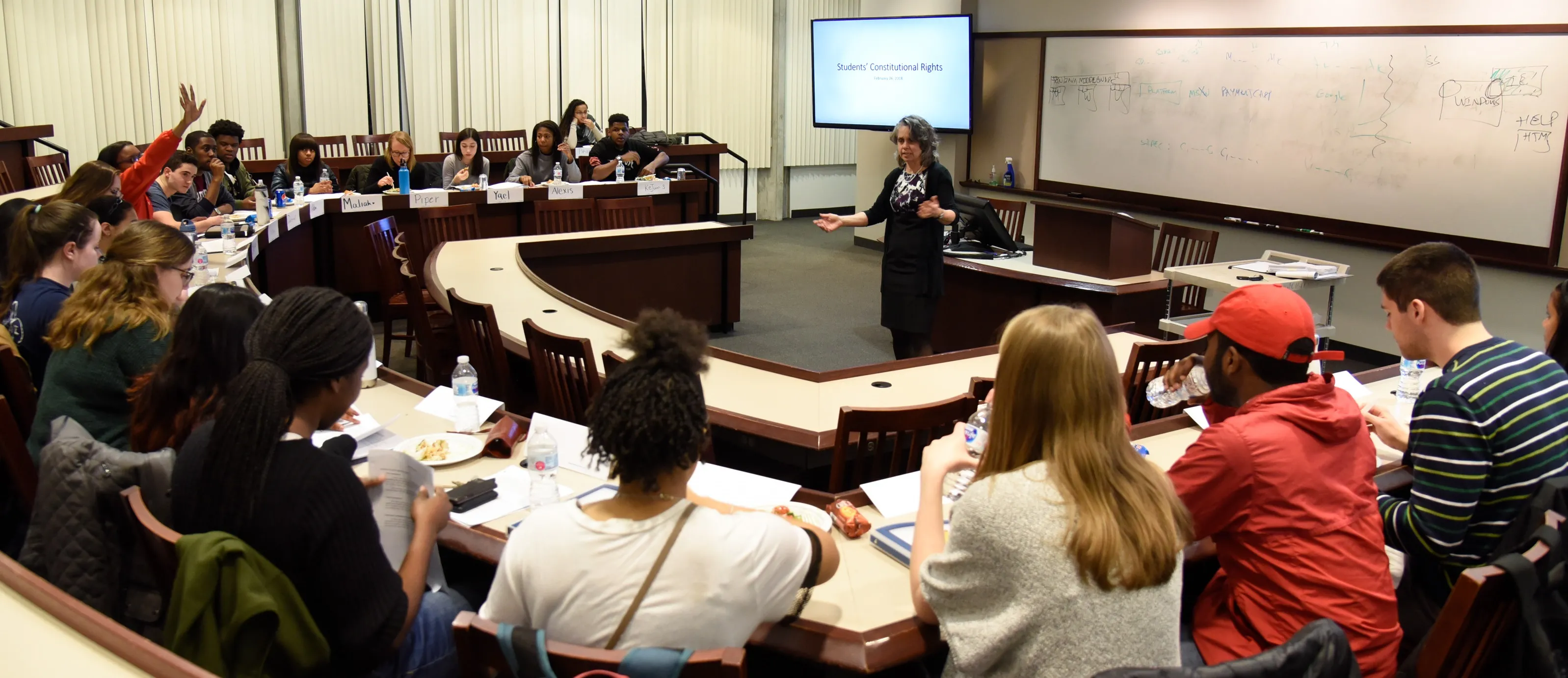Law School for Teens

Darrius Atkins, ’19, had a question for the four teenagers who were gathered in a University of Chicago Law School seminar room one night last month: did the US Supreme Court get it right when they ruled in Wisconsin v. Yoder that the state couldn’t force Amish parents to send their children to school after eighth grade? Should an Amish family’s right to express their religious beliefs trump the state’s interest in educating children?
The high school students were quiet at first, listening as Atkins and his fellow teaching assistant, Amanda Johnson, ’18, teed up the conversation about the 1972 case in their small-group breakout session. It was nearing 7 pm, and the teens had already had long days at school. But they were among 16 youth—half from the University of Chicago Woodlawn Charter School and half from the University of Chicago Laboratory Schools—who had signed up for Professor Emily Buss’s special Law School seminar on the constitutional rights of minors, and they were looking to dig in. This was a chance to experience a slice of law school, explore issues that affect young people, and learn from the eight Law School students who were serving as Buss’s teaching assistants.
“So, what do you think?” Atkins said, looking around the room. “Did the Court get it right?”
Lab student Stanley Shapiro said that, yes, the justices probably had. Those extra years of school might be unnecessary for a child whose community and faith were built around simple living and a rejection of worldly knowledge. But Woodlawn student Adam Wilson wasn’t so sure: he wondered if Amish teens who drop out might miss learning opportunities that could help their community, or themselves.
“Maybe not every Amish kid wants to be a farmer,” he said.
Atkins and Johnson started throwing out scenarios and questions: Was it fair that the exception only applied to the Amish? Did it matter that the case used eighth grade as the cutoff for mandatory schooling as opposed to, say, ninth grade or tenth grade? And what about Amish children who disagree with their parents and want to stay in school? Should the ruling have addressed their rights, as Justice William O. Douglas had in his partial dissent? And if the students’ rights did come into play, would an eighth-grader be mature enough to reasonably weigh in?
“In eighth grade, you really don’t know exactly what you want to do with your life,” Wilson said. High school, he added, is when a lot of kids start to figure stuff out.
It was just the kind of conversation Buss had hoped for when she decided to offer the winter quarter class, The Constitutional Rights of Minors from the Minors' Point of View, a reprise of the joint law school/high school class on juvenile justice that she’d offered in 2015. During that first class, which also included students from Woodlawn and Lab, Buss had seen how teens’ experiences often shaped their understanding of the law—and how their perspectives, in turn, could influence a conversation. She’d seen the positive interactions between teens and law students, including the mentoring relationships that emerged, and the additional layer of learning that came when law students were tasked with complicated issues to teenagers.
“One of the things that I loved—and was eager to do again—was collaborating with law students in teaching law, which is a wonderful and meaningful way for law students to learn,” said Buss, the Mark and Barbara Fried Professor of Law. “The high school students were engaged in a way that allowed for discussions that went pretty deep pretty quickly, and both I and the law school students learned from them.”
This time around, Buss knew she wanted to focus on the school setting—zeroing in on students’ rights, starting with Tinker v. Des Moines Independent School District, the 1969 case that defined students’ constitutional rights in public schools.
“There’s a whole body of constitutional law where doctrine has been developed for adults and then applied in the school context to kids because public schools and charter schools are state actors and therefore the constitution is implicated whenever the school acts,” she said. “That has led to cases on free speech, religious exercise , search and seizure, and due process. In this class, we also thought about the right to education itself, and about race and school placement.”
Many of the Law School students already had experience working with youth. Atkins, for instance, taught Sunday school; Alyssa Howard, ’19, taught middle school math in Kansas City for two years as part of Teach for America; Piper Pehrson, ’18, taught kindergarten for five years in the San Francisco area; and Michael Conway, ’19, coached youth swimming. All have studied the topic; most had taken Buss’s Constitutional Law VII: Parent, Child, and State class or Professor Justin Driver’s The Constitution Goes to School.
“I took [Driver’s class] and was interested in—and sometimes disheartened by—the scope of students' constitutional rights in the classroom,” Howard said. “I wanted to be able to engage with students on these topics and help them situate their own experiences within these cases. Every class, I was really blown away by the students' abilities to engage on difficult issues and apply them to their own experiences.”
Each of the eight sessions focused on a single case, from Bethel v. Fraser (which dealt with free speech in public schools) to New Jersey v. T.L.O (which considered whether a school’s search of a student’s purse was constitutional under the Fourth Amendment) to Goss v. Lopez (which focused on due process). Buss—who asked students to read each case, in edited form, in advance—began each of the two-hour classes with a half-hour lecture peppered with a few friendly cold calls. The students then broke into small groups for an hour before reconvening to process those discussions as a class.
“I learned how reasonable and rational high school students are in discussing their constitutional rights,” Conway said. “It makes me think their voices ought to be considered more when courts try to determine the shape of constitutional rights in schools. Several Supreme Court cases seem to fear that affording students too many rights will lead to a Lord of the Flies situation. But in this experience, students were willing and capable of recognizing limits to a student's constitutional rights relative to an adult's—even when they advocated expanding student rights.”
The teens’ personal experiences often shaped their approach to particular issues, and interesting conversations emerged as they compared how rights differ between students at Lab, an independent private school, and students at Woodlawn, which is a public charter school.
“On the first day, they discovered that the Woodlawn students have constitutional rights in school and the Lab students don’t—the Constitution doesn’t apply at Lab because it’s not a state actor,” Buss said. “That was a funny moment. But then [the Lab students found] that pursuant to school policy, they had many of the same protections, set out in their student handbook. Still, they realized: that, unlike their Woodlawn classmates, those protections were not enforceable rights under the Constitution.””
The class was singular Law School experience, Pehrson said: a chance to work with young people, engage in the broader Hyde Park and University of Chicago community, and see the law through a new lens. During one small-group session, the teens were particularly animated as they discussed Fourth Amendment protections against unreasonable search and seizure, she said.
“They had questions about stop-and-frisk, about how the police are able to stop and search people on the street,” Pehrson said. “They were making all these connections and [working to] understand what their own rights are and how they can advocate for them.”
Atkins, who had once dreamed of becoming a high school history teacher until he “fell in love with the law,” said he worked to help students both connect their personal experiences to the law and expand beyond their own perspectives.
“There was one exchange between two students whose arguments relied on assumptions that weren’t necessarily true across the board—but, in the end, I think they got insight into each other’s worlds,” he said. “That was a very common theme throughout the course. Students shared perspectives based on what they thought the world was, which was based on their own experiences. But then they would hear from a classmate with different experiences, and it would broaden their perspective. As the course developed, I saw a diminishing of those walls, and I saw students considering their classmates’ perspectives more often than they had at the beginning of the course. It was powerful to witness.”
When they gave feedback at the end, a majority of the high school students said they wished they’d had more time in class: they either wanted the classes to go longer than two hours, the quarter to go longer than eight weeks—or both.
“It was as unique for them as it was for us,” Pehrson said. “They’re not typically in small groups with two adults talking about their ideas, and learning a new way of thinking and learning how to apply a legal framework to understand the issues they encounter in their school.”
Buss said she hopes the class gave the high school students a sense for their rights and a taste of the law, and she hopes the Law School students found that their own understanding of the law was enhanced by their interaction with the teens.
And, as was the case last time, she hopes that the class helped make connections in the broader community.
“I hope the law students felt like they were part of the Hyde Park community,” she said. “I also hope they felt they were able to share their skills and commitments with that community and extend it beyond the small world of the Law School.”






